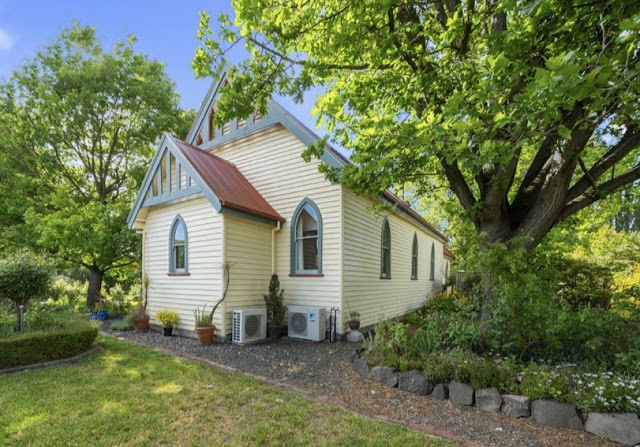No. 618 - Glenora Uniting (Methodist) Church - "Peace be within these walls"
Glenora is a country village in the Derwent River Valley approximately 20 kilometres west of New Norfolk. It is situated in the centre of a hop-growing district on the banks of the Styx River. In 1888 the Derwent Valley Railway reached Glenora enabling the growth of the fruit and hop growing industry.
Glenora’s only place of worship, a Uniting Church, has been closed for many years. After its closure the old heritage listed church was converted into a house in 1998. When I visited the area earlier this year the property was up for sale. [See link at the bottom of the page]
Glenora’s only place of worship, a Uniting Church, has been closed for many years. After its closure the old heritage listed church was converted into a house in 1998. When I visited the area earlier this year the property was up for sale. [See link at the bottom of the page]
The church’s origins date back to 1896 when a Wesleyan Methodist church was built as part of the New Norfolk circuit which at the time included churches at Back River, Mount Lloyd and Uxbridge. The foundation stone for the Glenora church was laid on 16 September 1896 in a ceremony led by Reverend William Shaw from Hobart.
The church was officially opened in mid December 1896. The Hobart Mercury published a report on the opening ceremony:
“A pleasing addition has been made to the village of Glenora in the erection of a Wesleyan church. The building, which was designed gratuitously by Mr. J. Maddison, of Hobart, is of weatherboard, and is 43ft. by 23ft,, with a porch and a large vestry, 20ft. by I8ft. The whole structure is of Tasmanian timber, and is beautifully stained and varnished. The spacious rostrum is well carpeted, and surmounted by a neat reading desk of modern design…. On Sunday last the Rev. W. Shaw, chairman of the Hobart district, conducted the opening services and preached two powerful and impressive sermons; in the morning…, and in the evening… The church was suitably decorated with pot plants, and on the end wall was the appropriate motto "Peace be within thy walls”, designed and executed by the Christian Endeavourers…”.
According to Max Stansall the church was very active in its early years:
“Due to the energetic support of the Shoobridge family, this church in its hey-day held two services every Sunday and had a Church choir and a Sunday-school. Harvest Festivals were a highlight of the Church year and the auction of goods was for many years conducted in a hop kiln”.
In the 1920’s the church’s name was changed to the Bushy Park Methodist church when it became a part of a seperate circuit. After the establishment of the Uniting Church in 1977 it was called the Glenora Uniting Church up until the time of its closure in the early 1990’s.
Additional information and sources about this church are most welcome as all articles are updated. I can be contacted through this page or my Facebook page "Churches of Tasmania" which is linked here: Churches of Tasmania.
“A pleasing addition has been made to the village of Glenora in the erection of a Wesleyan church. The building, which was designed gratuitously by Mr. J. Maddison, of Hobart, is of weatherboard, and is 43ft. by 23ft,, with a porch and a large vestry, 20ft. by I8ft. The whole structure is of Tasmanian timber, and is beautifully stained and varnished. The spacious rostrum is well carpeted, and surmounted by a neat reading desk of modern design…. On Sunday last the Rev. W. Shaw, chairman of the Hobart district, conducted the opening services and preached two powerful and impressive sermons; in the morning…, and in the evening… The church was suitably decorated with pot plants, and on the end wall was the appropriate motto "Peace be within thy walls”, designed and executed by the Christian Endeavourers…”.
According to Max Stansall the church was very active in its early years:
“Due to the energetic support of the Shoobridge family, this church in its hey-day held two services every Sunday and had a Church choir and a Sunday-school. Harvest Festivals were a highlight of the Church year and the auction of goods was for many years conducted in a hop kiln”.
In the 1920’s the church’s name was changed to the Bushy Park Methodist church when it became a part of a seperate circuit. After the establishment of the Uniting Church in 1977 it was called the Glenora Uniting Church up until the time of its closure in the early 1990’s.
Additional information and sources about this church are most welcome as all articles are updated. I can be contacted through this page or my Facebook page "Churches of Tasmania" which is linked here: Churches of Tasmania.
 |
| The church was converted into a house in the 1990's. Photograph courtesy of L.J. Hooker Glenorchy |
 |
| The Glenora district in 1901. The church and fruit packing sheds can be seen in the distance. Source: Weekly Courier |
 |
| Possibly the Hop Kiln used by the Methodists for the auction of goods at the annual Glenora Harvest Festival. Source: Weekly Courier |
 |
| A fruit storage building at Glenora - Source: Weekly Courier |
Sources:
Mercury, Monday 14 September 1896, page 4
Mercury, Thursday 17 December 1896, page 2
Tasmanian News, Friday 18 December 1896, page 3
The Weekly Courier, Saturday 6 June 1901
Stansall, M. E. J and Methodist Church of Australasia Tasmanian Methodism, 1820-1975 : compiled at the time of last Meeting of Methodism prior to union. Methodist Church of Australasia, Launceston, Tas, 1975.
Link to Real Estate page HERE



Comments
Post a Comment